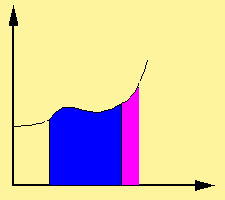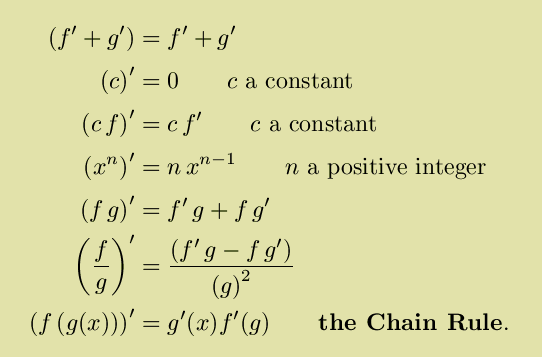
 Calculus Summary
Calculus Summary
 Calculus Summary
Calculus Summary

One important fact to keep in mind is that


The derivative of f(x) at x=a (or f´(a) ) is defined as


Also, if you have an implicitly defined function between x and y like x2 - 2 x y + y2 = 1, then you can perform implicit differentation (basically, just taking the derivative of everything with respect to both x and y are tacking on dxs and dys to indicate which) to get 2x dx - 2 x dy - 2 y dx + 2 y dy = 0. Then if you solve for dy/dx, this will be equal (by the chain rule) to y´ and if you solve for dx/dy, this will be equal to x´. Note that in this case, either derivative will be in terms of both x and y.
You may be wondering about the derivatives of your favorite trigonometric functions. Well,



Finally, derivatives can be used to help you graph functions. First, they give you the slope of the graph at a point, which is useful. Second, the points where the slope of the graph is horizontal (f´(x) = 0) are particularly important, because these are the only points at which a relative minimum or maximum can occur (in a differentiable function). These points where f´(x)) = 0 are called critical points. To determine whether a critical point is a minimum or maximum, or more generally to determine the concavity of a function, second derivatives can be used; f´´(x) < 0 means a relative maximum/concave down, f´´(x) > 0 means a relative minimum /concave up. Finally, taking the limit as x goes to positive or negative infinity gives information about the function's asympotitic behavior. Towards that end, derivatives can help you out with some difficult limits: by L'Hôpital's rule, if lim f(x) and lim g(x) are both zero, then lim f(x)/lim g(x) = lim f´(x)/lim g´(x). The proof of L'Hôpital's rule relies on the Mean Value Theorem: that for any function f(x) differentiable between a and b, there is some point c between a and b such that the derivative of f at c is the same as the average slope between a and b:


As stated before, integration and differentiation are inverse operations. To be precise, the fundamental theorem of calculus states that





If those properties aren't enough to solve your integral, and if you can't find it in any table, then here are some further tricks of the trade:






